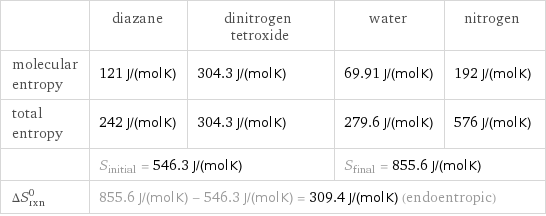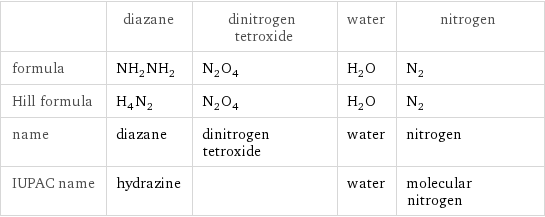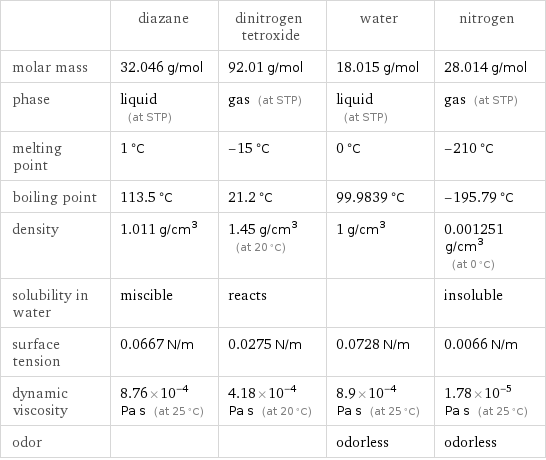Input interpretation

NH_2NH_2 diazane + N_2O_4 dinitrogen tetroxide ⟶ H_2O water + N_2 nitrogen
Balanced equation

Balance the chemical equation algebraically: NH_2NH_2 + N_2O_4 ⟶ H_2O + N_2 Add stoichiometric coefficients, c_i, to the reactants and products: c_1 NH_2NH_2 + c_2 N_2O_4 ⟶ c_3 H_2O + c_4 N_2 Set the number of atoms in the reactants equal to the number of atoms in the products for H, N and O: H: | 4 c_1 = 2 c_3 N: | 2 c_1 + 2 c_2 = 2 c_4 O: | 4 c_2 = c_3 Since the coefficients are relative quantities and underdetermined, choose a coefficient to set arbitrarily. To keep the coefficients small, the arbitrary value is ordinarily one. For instance, set c_2 = 1 and solve the system of equations for the remaining coefficients: c_1 = 2 c_2 = 1 c_3 = 4 c_4 = 3 Substitute the coefficients into the chemical reaction to obtain the balanced equation: Answer: | | 2 NH_2NH_2 + N_2O_4 ⟶ 4 H_2O + 3 N_2
Structures

+ ⟶ +
Names

diazane + dinitrogen tetroxide ⟶ water + nitrogen
Reaction thermodynamics
Enthalpy

| diazane | dinitrogen tetroxide | water | nitrogen molecular enthalpy | 50.6 kJ/mol | 11.1 kJ/mol | -285.8 kJ/mol | 0 kJ/mol total enthalpy | 101.2 kJ/mol | 11.1 kJ/mol | -1143 kJ/mol | 0 kJ/mol | H_initial = 112.3 kJ/mol | | H_final = -1143 kJ/mol | ΔH_rxn^0 | -1143 kJ/mol - 112.3 kJ/mol = -1256 kJ/mol (exothermic) | | |
Gibbs free energy

| diazane | dinitrogen tetroxide | water | nitrogen molecular free energy | 149.3 kJ/mol | 99.8 kJ/mol | -237.1 kJ/mol | 0 kJ/mol total free energy | 298.6 kJ/mol | 99.8 kJ/mol | -948.4 kJ/mol | 0 kJ/mol | G_initial = 398.4 kJ/mol | | G_final = -948.4 kJ/mol | ΔG_rxn^0 | -948.4 kJ/mol - 398.4 kJ/mol = -1347 kJ/mol (exergonic) | | |
Entropy

| diazane | dinitrogen tetroxide | water | nitrogen molecular entropy | 121 J/(mol K) | 304.3 J/(mol K) | 69.91 J/(mol K) | 192 J/(mol K) total entropy | 242 J/(mol K) | 304.3 J/(mol K) | 279.6 J/(mol K) | 576 J/(mol K) | S_initial = 546.3 J/(mol K) | | S_final = 855.6 J/(mol K) | ΔS_rxn^0 | 855.6 J/(mol K) - 546.3 J/(mol K) = 309.4 J/(mol K) (endoentropic) | | |
Equilibrium constant
![Construct the equilibrium constant, K, expression for: NH_2NH_2 + N_2O_4 ⟶ H_2O + N_2 Plan: • Balance the chemical equation. • Determine the stoichiometric numbers. • Assemble the activity expression for each chemical species. • Use the activity expressions to build the equilibrium constant expression. Write the balanced chemical equation: 2 NH_2NH_2 + N_2O_4 ⟶ 4 H_2O + 3 N_2 Assign stoichiometric numbers, ν_i, using the stoichiometric coefficients, c_i, from the balanced chemical equation in the following manner: ν_i = -c_i for reactants and ν_i = c_i for products: chemical species | c_i | ν_i NH_2NH_2 | 2 | -2 N_2O_4 | 1 | -1 H_2O | 4 | 4 N_2 | 3 | 3 Assemble the activity expressions accounting for the state of matter and ν_i: chemical species | c_i | ν_i | activity expression NH_2NH_2 | 2 | -2 | ([NH2NH2])^(-2) N_2O_4 | 1 | -1 | ([N2O4])^(-1) H_2O | 4 | 4 | ([H2O])^4 N_2 | 3 | 3 | ([N2])^3 The equilibrium constant symbol in the concentration basis is: K_c Mulitply the activity expressions to arrive at the K_c expression: Answer: | | K_c = ([NH2NH2])^(-2) ([N2O4])^(-1) ([H2O])^4 ([N2])^3 = (([H2O])^4 ([N2])^3)/(([NH2NH2])^2 [N2O4])](../image_source/afc773ce367ff99327fa009dbfdd8872.png)
Construct the equilibrium constant, K, expression for: NH_2NH_2 + N_2O_4 ⟶ H_2O + N_2 Plan: • Balance the chemical equation. • Determine the stoichiometric numbers. • Assemble the activity expression for each chemical species. • Use the activity expressions to build the equilibrium constant expression. Write the balanced chemical equation: 2 NH_2NH_2 + N_2O_4 ⟶ 4 H_2O + 3 N_2 Assign stoichiometric numbers, ν_i, using the stoichiometric coefficients, c_i, from the balanced chemical equation in the following manner: ν_i = -c_i for reactants and ν_i = c_i for products: chemical species | c_i | ν_i NH_2NH_2 | 2 | -2 N_2O_4 | 1 | -1 H_2O | 4 | 4 N_2 | 3 | 3 Assemble the activity expressions accounting for the state of matter and ν_i: chemical species | c_i | ν_i | activity expression NH_2NH_2 | 2 | -2 | ([NH2NH2])^(-2) N_2O_4 | 1 | -1 | ([N2O4])^(-1) H_2O | 4 | 4 | ([H2O])^4 N_2 | 3 | 3 | ([N2])^3 The equilibrium constant symbol in the concentration basis is: K_c Mulitply the activity expressions to arrive at the K_c expression: Answer: | | K_c = ([NH2NH2])^(-2) ([N2O4])^(-1) ([H2O])^4 ([N2])^3 = (([H2O])^4 ([N2])^3)/(([NH2NH2])^2 [N2O4])
Rate of reaction
![Construct the rate of reaction expression for: NH_2NH_2 + N_2O_4 ⟶ H_2O + N_2 Plan: • Balance the chemical equation. • Determine the stoichiometric numbers. • Assemble the rate term for each chemical species. • Write the rate of reaction expression. Write the balanced chemical equation: 2 NH_2NH_2 + N_2O_4 ⟶ 4 H_2O + 3 N_2 Assign stoichiometric numbers, ν_i, using the stoichiometric coefficients, c_i, from the balanced chemical equation in the following manner: ν_i = -c_i for reactants and ν_i = c_i for products: chemical species | c_i | ν_i NH_2NH_2 | 2 | -2 N_2O_4 | 1 | -1 H_2O | 4 | 4 N_2 | 3 | 3 The rate term for each chemical species, B_i, is 1/ν_i(Δ[B_i])/(Δt) where [B_i] is the amount concentration and t is time: chemical species | c_i | ν_i | rate term NH_2NH_2 | 2 | -2 | -1/2 (Δ[NH2NH2])/(Δt) N_2O_4 | 1 | -1 | -(Δ[N2O4])/(Δt) H_2O | 4 | 4 | 1/4 (Δ[H2O])/(Δt) N_2 | 3 | 3 | 1/3 (Δ[N2])/(Δt) (for infinitesimal rate of change, replace Δ with d) Set the rate terms equal to each other to arrive at the rate expression: Answer: | | rate = -1/2 (Δ[NH2NH2])/(Δt) = -(Δ[N2O4])/(Δt) = 1/4 (Δ[H2O])/(Δt) = 1/3 (Δ[N2])/(Δt) (assuming constant volume and no accumulation of intermediates or side products)](../image_source/dd681ba3972323404b3bec1a7da84dd5.png)
Construct the rate of reaction expression for: NH_2NH_2 + N_2O_4 ⟶ H_2O + N_2 Plan: • Balance the chemical equation. • Determine the stoichiometric numbers. • Assemble the rate term for each chemical species. • Write the rate of reaction expression. Write the balanced chemical equation: 2 NH_2NH_2 + N_2O_4 ⟶ 4 H_2O + 3 N_2 Assign stoichiometric numbers, ν_i, using the stoichiometric coefficients, c_i, from the balanced chemical equation in the following manner: ν_i = -c_i for reactants and ν_i = c_i for products: chemical species | c_i | ν_i NH_2NH_2 | 2 | -2 N_2O_4 | 1 | -1 H_2O | 4 | 4 N_2 | 3 | 3 The rate term for each chemical species, B_i, is 1/ν_i(Δ[B_i])/(Δt) where [B_i] is the amount concentration and t is time: chemical species | c_i | ν_i | rate term NH_2NH_2 | 2 | -2 | -1/2 (Δ[NH2NH2])/(Δt) N_2O_4 | 1 | -1 | -(Δ[N2O4])/(Δt) H_2O | 4 | 4 | 1/4 (Δ[H2O])/(Δt) N_2 | 3 | 3 | 1/3 (Δ[N2])/(Δt) (for infinitesimal rate of change, replace Δ with d) Set the rate terms equal to each other to arrive at the rate expression: Answer: | | rate = -1/2 (Δ[NH2NH2])/(Δt) = -(Δ[N2O4])/(Δt) = 1/4 (Δ[H2O])/(Δt) = 1/3 (Δ[N2])/(Δt) (assuming constant volume and no accumulation of intermediates or side products)
Chemical names and formulas

| diazane | dinitrogen tetroxide | water | nitrogen formula | NH_2NH_2 | N_2O_4 | H_2O | N_2 Hill formula | H_4N_2 | N_2O_4 | H_2O | N_2 name | diazane | dinitrogen tetroxide | water | nitrogen IUPAC name | hydrazine | | water | molecular nitrogen
Substance properties

| diazane | dinitrogen tetroxide | water | nitrogen molar mass | 32.046 g/mol | 92.01 g/mol | 18.015 g/mol | 28.014 g/mol phase | liquid (at STP) | gas (at STP) | liquid (at STP) | gas (at STP) melting point | 1 °C | -15 °C | 0 °C | -210 °C boiling point | 113.5 °C | 21.2 °C | 99.9839 °C | -195.79 °C density | 1.011 g/cm^3 | 1.45 g/cm^3 (at 20 °C) | 1 g/cm^3 | 0.001251 g/cm^3 (at 0 °C) solubility in water | miscible | reacts | | insoluble surface tension | 0.0667 N/m | 0.0275 N/m | 0.0728 N/m | 0.0066 N/m dynamic viscosity | 8.76×10^-4 Pa s (at 25 °C) | 4.18×10^-4 Pa s (at 20 °C) | 8.9×10^-4 Pa s (at 25 °C) | 1.78×10^-5 Pa s (at 25 °C) odor | | | odorless | odorless
Units
